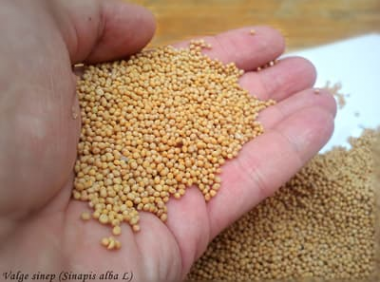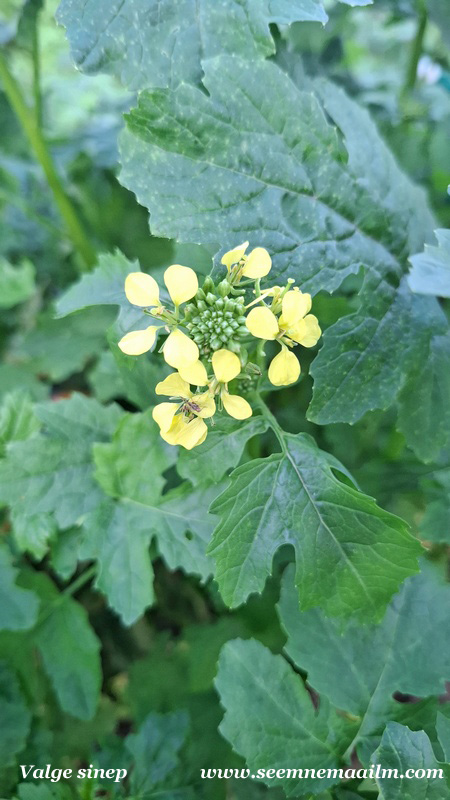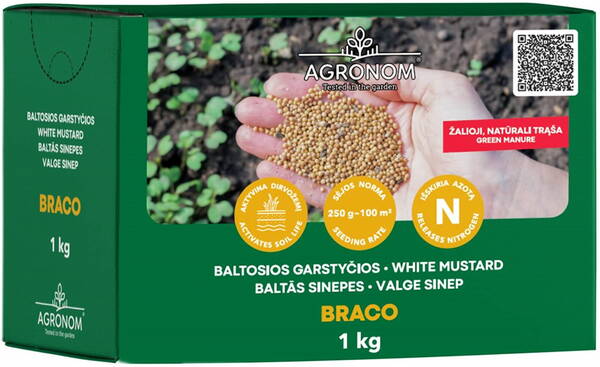The most convenient and cheapest type of organic fertilizer.
An annual oil plant from the Cruciferae family, which has the ability to release poorly soluble phosphates.
Can grow on any soil: with a pH from very acidic to alkaline.
Seeds germinate at a temperature of +3°C. Seedlings withstand short-term frosts down to -5°C.
Mustard sprouts quickly and grows quickly. The green mass is mown when the plant leaves are fresh, juicy, better before mass flowering, because when harvesting at a later date, the leaves will begin to die off and the organic mass will decrease, and the ripened seeds will clog the bed.
On average, the period from sowing to incorporating mustard into the soil is 55-70 days (8-10 weeks). It is better to incorporate it into the soil or dig it in a little (by autumn everything will have rotted).
Seeding rate: 2.5-4.0 g/m2.
Soil planting depth: 2-3 cm (sow lightly, raking into the soil). The next crop is planted no earlier than 3-4 weeks after the green mass has been planted.
The phytosanitary effect of mustard is also important - after its planting, the incidence of such common plant diseases as late blight, rhizoctonia, tuber scab, fusarium rot, including potatoes, decreases.
Mustard crops reduce the number of wireworms in the soil; it is also recommended to plow white mustard in late autumn; as a result of disruption of the wireworm's wintering, it dies. To increase the effectiveness of wireworm control, the mustard seeding rate is increased to 5.0 g/m2.
In recent years, many farmers have refused to use manure. It is difficult to obtain it in the required quantities, it is labor-intensive and expensive. Moreover, the area is infested with weeds (in case of using manure) and will require the use of herbicides or exhausting weeding. In this case, green manure will serve as a serious alternative to manure.
Green manure is understood as green manure crops, the fresh plant mass of which is used as fertilizer (plowed in) to enrich the soil with organic matter.
1.0 g = 145-150 seeds.

* What are the benefits of siderates?
Siderata stop the leaching of nutrients outside the root layer, pump nutrients from the deep horizons of the soil into the upper layer, and contribute to the accumulation of humus in the soil, which improves its properties. The more humus is contained in the soil, the lower its thermal conductivity and higher heat capacity, less physical evaporation of water from it, more productive use of soil moisture by cultivated plants. Humus contributes to the intensive development of beneficial soil microflora.
The biomass of the root systems of herbaceous plants plays an important role in enriching the soil with organic residues. When green fertilizer is applied, not only nitrogen, but also other nutrients are accumulated in the soil. Green fertilizer in the soil decomposes much faster than other organic fertilizers rich in fiber. Green fertilizer slightly reduces the acidity of the soil, significantly increases the permeability and moisture capacity of the soil, as a result of which the surface runoff of precipitation decreases and the moisture content in the soil increases sharply. As a green fertilizer (siderates), the following are mainly cultivated: lupine, sweet clover, mustard, alfalfa, phacelia.

Eng.: White mustard, MUSTARD YELLOW. Bot. syn.: Brassica hirta Moench, Sinapis alba L. subsp. alba.
We plant ... fertilizers.
"We kill two birds with one stone": we increase soil fertility and destroy weeds!
Green manure crops (green fertilizers) are grown on site to improve the structure of the soil and increase the content of nutrients in it. In addition, green manure is an ecologically clean source of organic matter; they contribute to the accumulation of humus in the soil. In terms of efficiency, these crops are equivalent to manure and are inferior to it only in terms of the content of phosphorus and potassium.
If you are just starting to develop a plot or are growing mainly annual plants in the garden, you can use green manure to control weeds along with classic weeding. They grow very quickly and will compete with weeds. Some green manure crops assimilate elements of mineral nutrition that are difficult to access for many vegetable and fruit plants from the soil. Later, during the decomposition of green manure, these elements are "released" and used by cultivated plants.
Plants from the legume family (lupine, peas, vetch, pelushka, seradella, clover, sweet clover) are suitable for "green fertilization", and from the cabbage family (mustard, rapeseed, oil radish) and other fast-growing plants (for example, buckwheat).
Legumes assimilate and accumulate nitrogen due to the symbiotic activity of nodule nitrogen-fixing bacteria.
Most cruciferous plants have phytosanitary properties: they suppress the development and reproduction of weeds, drive out such pests as nematodes and wireworms.
Planting cultivated plants immediately after plowing green manures is undesirable, since during the decomposition of the vegetative mass in the soil, active biochemical processes occur that suppress seed germination and plant growth. Therefore, you will have to wait 2-4 weeks and only after that start planting.
Dig up or plow the ground, loosen it, breaking all the clods, and level it with a rake. Spread green manure seeds by hand or with a seeder and lightly rake the ground. So that the green manure does not allow the weeds to grow, it is sown not in rows, but randomly - and then covered with a rake. Dig the green manure into the soil about 2-4 weeks before planting the main crop. If this is difficult, you can manually cut the green manure first and chop it up. The aboveground part of the green manure is plowed up on light soils to a depth of 15-18 cm, on heavy soils (clay) - by 12-15 cm (taking into account the fact that the younger the plant, the faster their vegetative mass decomposes).
In fruit orchards, it is better to use green fertilizers from legumes (lupine) or oat-pea mixture. Seeds are sown in early spring in tree trunks. The green mass of plants is plowed into the soil in the summer before budding begins. After that, you can immediately re-sow green manure crops. With early spring sowing, as soon as the snow melted, early ripening cold-resistant plants are picked up - mustard, oil radish, oats.
If time permits (for example, with late summer and autumn plantings in the aisles of the garden), it is best to bring green manure crops to the flowering stage.
When using green fertilizer, take into account this feature - do not plant plants from the same family as the green manure (for example, cabbage cannot be grown after an oilseed radish). This is due to the accumulation in the soil of pathogens or pests typical for plants of this family.















